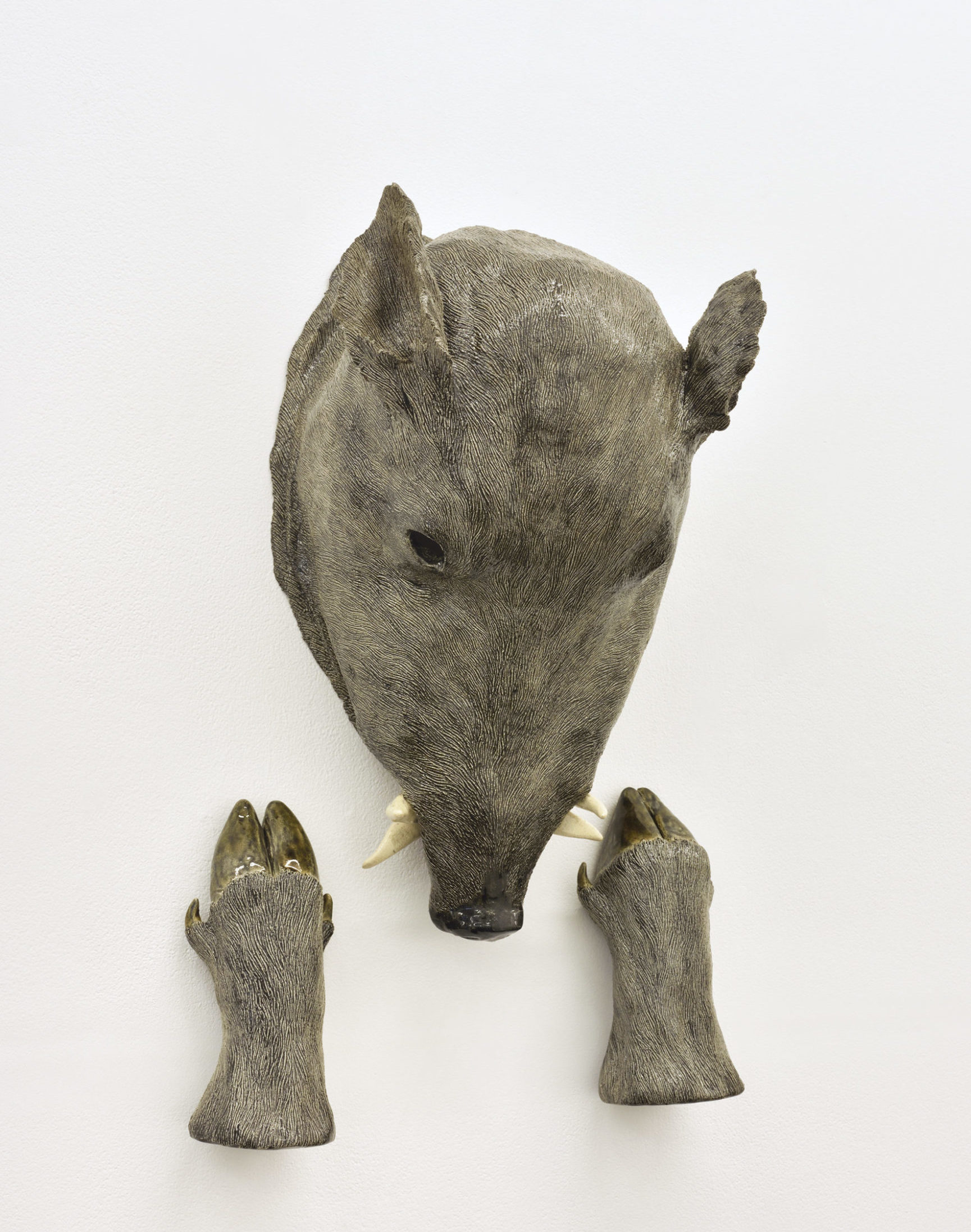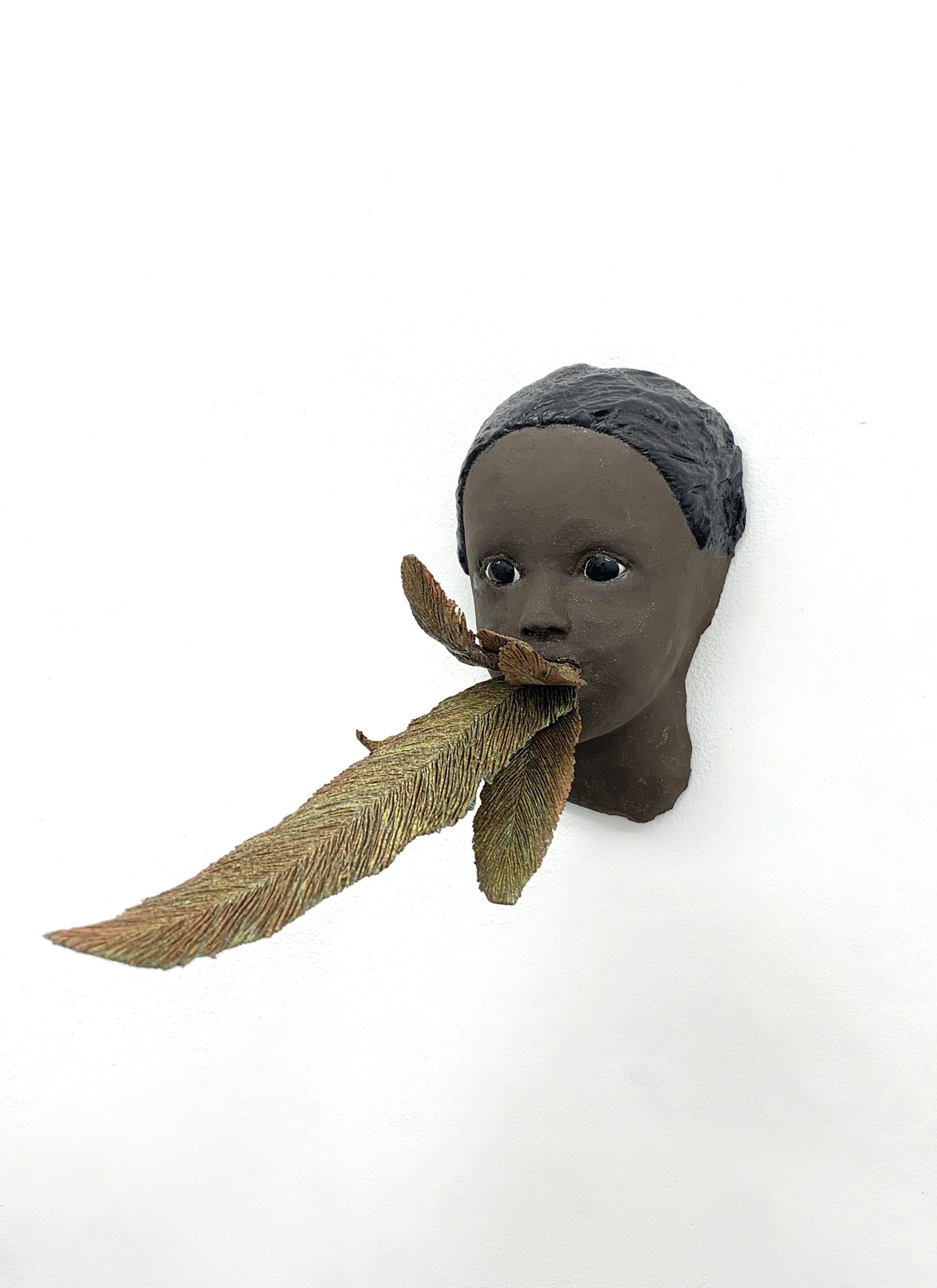
Exhibition view Gallery Maïa Muller – Copyright Rebecca Fanuele

Exhibition view Gallery Maïa Muller – Copyright Rebecca Fanuele
All the cattle are deployed by these admirable image-makers who followed the humble brotherhoods of the “Lodgers of the Good Lord” and, under the orders of the project manager, sculpted these prodigious cathedrals whose towers rose to the chanting of the psalms. 1
Joris-Karl Huysmans
On the floor, an old clock body made of brown wood pulls towards the sky where the eye stops: in the empty dial, minutes torn out, slumbers a firmament of blues, greys and bronze greens of water that would have pleased Gaston Bachelard. Water changes into a type of intimacy, a type of destiny that is no longer simply the vain destiny of fleeting images and a never-ending dream, but an essential destiny that endlessly transforms the substance of the being.2 The ascent freezes. The clock is crowned with a Corinthian capital of jet black to beyond-black crows: farewell to the elevation of hymns towards the Angelus and the Annunciation, welcome to anxiety and the restless night. A disorientation, a disorder operates. Verticality first – the clock as a metaphor for a column and the elevation of psalms (both have their origins in religious chants, the Canticle being considered the Song of Songs, dedicated to King Solomon) – then ovality with a dial that inevitably evokes the oval of Byzantine influence and which in Italy is called mandorla (almond) and which we use to describe the form that houses Christ in all Last Judgments – and finally, the horizontality of the water which seems to say on the one hand “everything flows”, credo of Heraclitus the Obscure, but also that the pain of water is infinite. A dreamy melancholy, slow and calm.
Gretel Weyer has called it Canticle of Crows
Like such dimdissolving music of the sun requiemed down through the sea3 it goes from the disturbing strangeness of Freud, of Sade, of bliss mixed with fear: a source of pleasure to which is added the ambiguous duality of the crow. Are La Fontaine’s fables to blame if we retain the evil bird and forget the messenger of the Gods, seated on Odin’s shoulders and responsible for flying around the world every day and reporting what it saw and heard? Here he is infallibly perched above a quasi-gallows: it is Manet illustrating Edgar Allan Poe, a bird of bad omen! Hitchcock making them screech in the face of Beauty, bird of misfortune! death at the place of Van Gogh and his Wheatfield with Crows. Fateful bird! Over nature bereft of blooms,
Make the crows, my darlings and delights,
Swoop down from soaring heights 4 in the oblivion of the soothsayers who liked to tell the future from the inflections of his voice. A question of symbolic colour too, that modern times have inherited: from Fantômas to Dracula, the vampire is dressed in black.
Gretel Weyer had accustomed us to the wonderful and the fantastic, to the tradition inherited from fauns and monsters, to deformity, to condemned hermaphrodites, to the Centaur, to the iconography of the Middle Ages, to pacing between Egyptian metempsychoses (displacements of souls between man and animal), the Hellenistic metamorphoses (Ovid) and, in the deluge of toads, we lowered our ears already when we heard this sound: the rustle of animals crawling, swarming and piling up, as if for a pyre, almost crackling. A reddening black sky, a dark Fallen Angel figure on its promontory: Le Creux de l’Enfer (The Hollow of Hell), an enamelled ceramic produced in 2019 announced it.
When you talk of Canticle of crows, you talk of Animal musicians.
On the balustrades and arches of cathedrals, the visible forms are symbolic, one might say, but the goat takes the drum (Les Obsèques de Renard), the pig is a zither player and the goat is a harpist (Notre-Dame de Beaune), the donkey old (Chartres cathedral) and in Strasbourg, nearer to Gretel, Brichemer celebrates mass. Placing this canticle in the fine medieval iconography of musical animals, here it is companion to the Sow playing the tuba at the museum of the Echevinage in Poitiers, the zither- playing goat at the Limoges museum, the flautist goat astride a monster on the crypt of Canterbury Cathedral, and the donkey playing the psaltery in the crypt of Saint-Parize-le-Châtel. 5 The analogy ends there: these bas-reliefs are to the Middle Ages – a warning against pride – what Louis de Funès was on television, we are drowning in burlesque, the Middle Ages like to laugh. As well. With Gretel Weyer, laughter turns yellow, La fête est finie,(The party is over , ceramics, 2012, Collection of the Museum of Modern Art in Strasbourg). Music again. This noise, this song, this sound linked to an image, is it speech? (We are here on the brink of reconnecting with something lost to us: speech, which draws as much from the image as from the sound of writing; the Egyptian hieroglyph and the Chinese ideogram). Because finally, this speech is also the metaphor of Orpheus charming the animals and Adam naming the animals. The first descends to the infernal world so as not to lose his wife Eurydice, bitten by a snake, Adam sins and abandons the Edenic world, lost through the actions of Eve.
So growls the nostalgia cause of infinite debt: paradise lost. Carved in clay, is it this child whose legs dangle above a cabinet of curiosities, like a lookout, mixing waiting with resistance to temptation and to falling, who acts as a predator? With painted lips, he hovers like a verse from the Book of Revelation of Saint John when, from the throne came flashes of lightning, and rumblings and peals of thunder (…) And around the throne, on each side of the throne, are four living creatures, full of eyes in front and behind. The cabinet exhibits its fragments of animals, languidly draped with cold eyes, fish, bear, donkey, fox, scattered limbs that wrinkle open jaws. On a small chair flow the fabrics of decapitated geese. The night of the hunter gives its corpses a makeover. Both on stage and in the gallery, Gretel Weyer hybridises this theatre of cruelty.
First plinth, first act: the devil takes the form of a flared cup, with an interlacing of green asps with oval pupils all together, intertwined like so many stalks which evoke an anatomical plate of organs, rising like branches playing with the contours of cistus leaves, and in the confusion of protruding snouts, rising like caruncles, the cup is full of snakes. Visions of medusas by Rubens or Caravaggio, turned upside down. Gretel has half-Italian blood in her veins.
Second plinth, second act: a Proto-Attic amphora, making a detour via Greece, belches a cloud of butterflies which make a hyphen with two trophies of a boar and bear, dismembered legs, which lead a separate life and contribute to our growing dread. In the gallery, the final act of the Bohemian crystal vase, with the bubbles you blew as a child, (…) an ephemeral dawn of reflections 6, a painted wood serves as the background for the winged serpent separating two face-to-face young girls in a pre- Raphaelite posture, and which evokes for a moment the Edward Burne-Jones of The Baleful Head, but here in an almost hieroglyphic profile. The two women spit out a string of crystal bubbles, for which it is not possible to say whether they inhale by evaporation or whether, with their hand on their stomachs, they vomit. Spells and Incantations, 2019.
In the pit of the belly, we cross our fingers, a paradox of the body. And it is with beating heart that one imagines that one has strolled innocently, that one is suddenly surrounded, between the hairy clogs for shoes and the severed limbs, the flight of butterflies, the bird of prey. In the center, you and me, more exactly circled.
It’s as if at 19 rue Chapon, halfway between love and death, we whispered “Come, it’s an embrace”, and that in a secret rite, the ghost of Echidna, half-woman, half-serpent, has coupled with the giant Typhon, whose body is furrowed with vipers ambushed in thickets of feathers, whose mouth spits darts and chews flames. 7 Here you are in Greece, here you are in Rome, you are as much with the Egyptian canopies as with Isidore of Seville, you were at the heart of a revenge taken on all the unpunished infanticides for deformity of Ancient Rome, of all the children and monsters thrown from Mount Taygetos. RENAISSANCE. In the style of Gretel Weyer.













